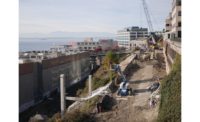Preparations Underway for Demolition of Seattle's Alaskan Way Viaduct

Removal of the 1.4-mile viaduct along waterfront begins next year.
PHOTO COURTESY OF WSDOT
Intense planning is underway regarding how to safely demolish the 1.4-mile concrete double-decker Alaskan Way Viaduct, beginning in February. Around that time, the Washington State Dept. of Transportation (WSDOT) plans a grand opening of a two-mile bored tunnel under downtown Seattle, a piece of the $3.3-billion project with the goal of replacing the viaduct.
The six-month, $93.7-million demolition of the seismically vulnerable viaduct, opened in 1953, won’t look that different from any other double-decker project, says Dan Hemenway, project director with Kiewit Infrastructure West Co., which leads the design-build team doing the job. “What makes this unique is the close proximity of the buildings and the massive grids of utilities we are going to be protecting,” he says. “We will have two to three blocks secured off at a time, and have 30 days to get in, do the work and get out.”
The contract stipulates that Kiewit only has 30 days to complete work in each section. Kiewit’s plan involves removal of the top deck, followed by the lower deck and then the columns.
“It will be challenging to tear down a major highway in the heart of a booming city, but we’re looking forward to getting it done safely and as quickly as possible,” says Brian Nielsen, WSDOT’s viaduct program administrator.
When buildings are within 5 ft of the viaduct, crews will use cranes to remove girders. In other places they will employ debris barriers. Sensors will ensure noise and vibrations remain within allowable limits. To combat the dust of demolition, Hemenway says crews will use plenty of water, which will get tested before getting sent to a wastewater treatment plant.
Kiewit was awarded the design-build contract in May, giving the firm time to plan. Many factors influence the removal path, but none prove stronger than ties to additional projects. For example, Seattle has plans to turn Columbia Street into a two-way street with room for buses, so work will start on removal of a viaduct on-ramp as well as the area north of Pike Street. From Columbia, Kiewit will move both south and north at the same time.
During the six-month project, the waterfront, Pike Place Market and Pioneers Square will stay accessible, and Alaskan Way will remain open to traffic at all times nearly directly below the viaduct—the roadway was recently shifted to the west. “Our goal is to have as little impact as possible,” Hemenway says.
At the same time, Kiewit crews will begin filling and sealing the 1950s-created Battery Street Tunnel, a portion of the State Route 99 highway no longer needed with the opening of the new tunnel. Work on the tunnel will last into late 2020.
All debris from the viaduct project will be taken to Terminal 25 for processing. Metal rebar will get recycled and concrete will help fill the Battery Street Tunnel.





